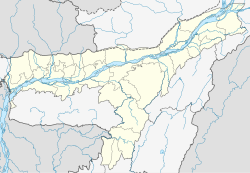
Back শদিয়া Assamese সাদিয়া (শহর) Bengali/Bangla Sadiya Catalan Sadiya Spanish सदिया Hindi ᱥᱚᱫᱤᱭᱟ SAT صدیا Urdu
Sadiya | |
|---|---|
town | |
| Nickname: Starting point of Assam | |
| Coordinates: 27°50′N 95°40′E / 27.83°N 95.67°E | |
| Country | |
| State | Assam |
| District | Tinsukia |
| Elevation | 123 m (404 ft) |
| Languages | |
| • Official | Assamese |
| Time zone | UTC+5:30 (IST) |
| Vehicle registration | AS 23 |
Sadiya is a town in Tinsukia district, Assam, in India. It was the capital of the Chutia Kingdom but after the downfall of the kingdom, Prasengmung Borgohain was appointed as the Sadiya-khowa-Gohain of the Ahom kingdom.[1] Extensive remains of buildings and fortifications built during the Chutia rule near Sadiya point to the importance of the region in the past. Historically Sadiya referred to the Chutiya kingdom which included at times the districts of Lakhimpur, Dhemaji and Tinsukia. It is claimed to be the center of development of the eastern Assamese dialects, the inscription here are written in a Tai script.[2] Its stands on a grassy plain, almost surrounded by forested Himalayan mountains, on the right bank of Lohit River which is locally (but erroneously) considered the main stream of the Brahmaputra River.[3] The deepest point of the Brahmaputra River is located near this village. It is famous for a flower named satphul (the word means "blessing" or a "desert flower"), which is much like Jasmine.
There are three possible routes from Sadiya to Tibet.[4] The first route is through the valley of Dihang or Tsang Po. The second one through the Dibang valley and the third route through the Lohit valley which leads to Zayul province, the extreme south-eastern province of Tibet.[5] It acted as a trade route which passed through the Shan state of Mongkawng and then finally reaches to Yunnan.[6]
- ^ (Col. Ved Prakash:912)
- ^ Saikia 2004, p. 6.
- ^ One or more of the preceding sentences incorporates text from a publication now in the public domain: Chisholm, Hugh, ed. (1911). "Sadiya". Encyclopædia Britannica. Vol. 23 (11th ed.). Cambridge University Press. p. 993.
- ^ "From Sadiya there are three possible routes through the mountains into Tibet"(Kaulback 1934, p. 177)
- ^ Kaulback 1934, p. 177.
- ^ (Laichen 2000:189)

